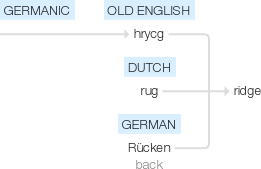Ridge
Old English hrycg ‘spine, crest’, of Germanic origin; related to Dutch rug and German Rücken ‘back’.
wiktionary
From Middle English rigge, rygge, (also rig, ryg, rug), from Old English hryċġ(“back, spine, ridge, elevated surface”), from Proto-Germanic *hrugjaz(“back”), from Proto-Indo-European *(s)kreuk-, *(s)ker-(“to turn, bend”). Cognate with Scots rig(“back, spine, ridge”), North Frisian reg(“back”), West Frisian rêch(“back”), Dutch rug(“back, ridge”), German Rücken(“back, ridge”), Swedish rygg(“back, spine, ridge”), Icelandic hryggur(“spine”). Cognate to Albanian kërrus(“to bend one's back”) and kurriz(“back”).
etymonline
ridge (n.)
Middle English rigge, from Old English hrycg "back of a man or beast," probably reinforced by Old Norse hryggr "back, ridge," from Proto-Germanic *hruggin (source also of Old Frisian hregg, Old Saxon hruggi, Dutch rug, Old High German hrukki, German Rücken "the back"). OED says "of uncertain relationship;" Pokorny, Boutkan, and Watkins have it from PIE *kreuk-, extended form of root *sker- (2) "to turn, bend."
The original "back" sense, predominant in Middle English, seems to have become archaic 17c. Also in Old English, "the top or crest of anything," especially when long and narrow, based on resemblance to the projecting part of the back of a quadruped, the "ridge" of the backbone. Probably also in late Old English "a long elevation of land, a long, narrow range of hills," implied in place-names. From late 14c. of the highest part of the roof of a building, also the strip of ground thrown up between two plowed furrows. The spelling with -dg- is from late 15c.
Ridge-runner, somewhat derisive term for "Southern Appalachian person, hillbilly," especially an upland white farmer of the Ozarks region, is recorded by 1917 (it later came into use in other regions). Also "person who wanders from place to place," often with a suggestion of illicit intent (1930).
